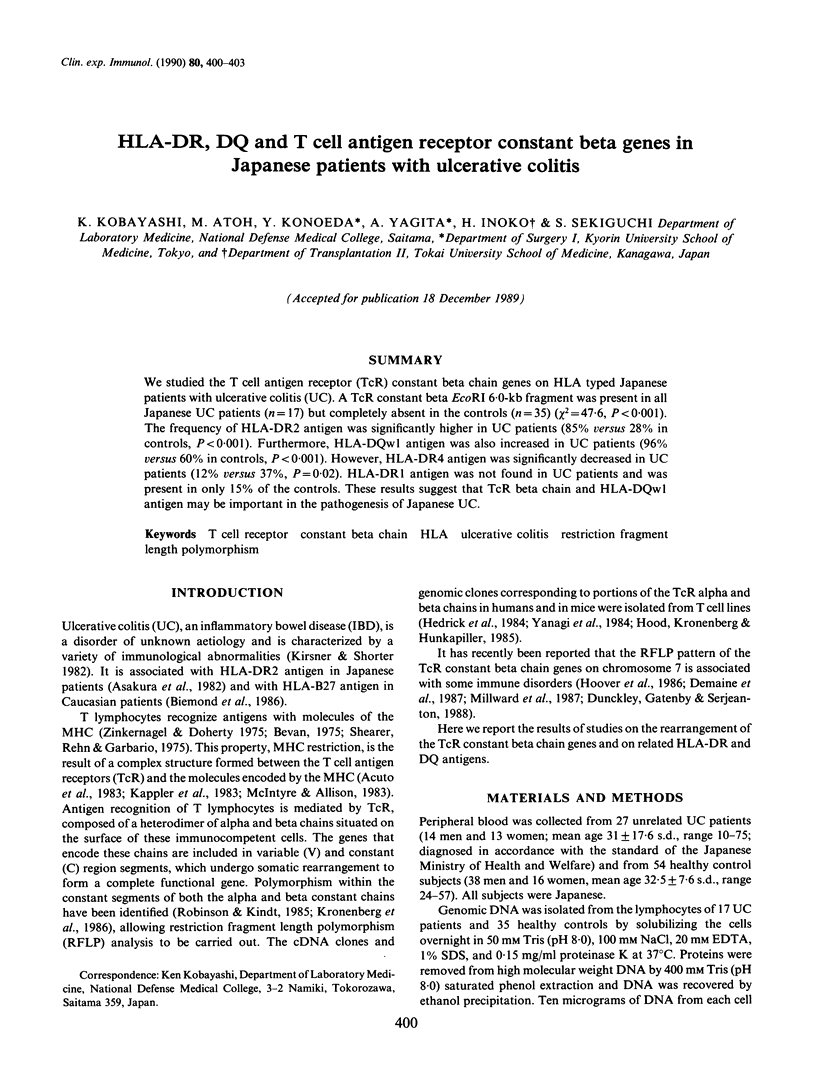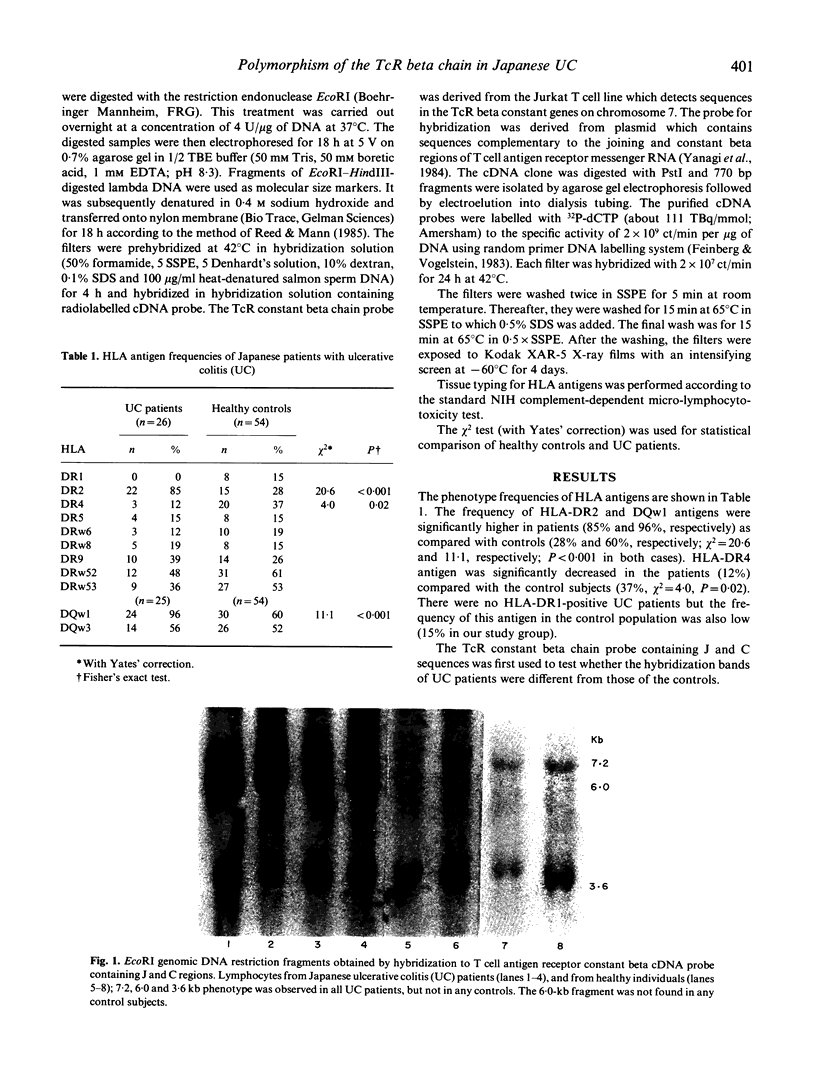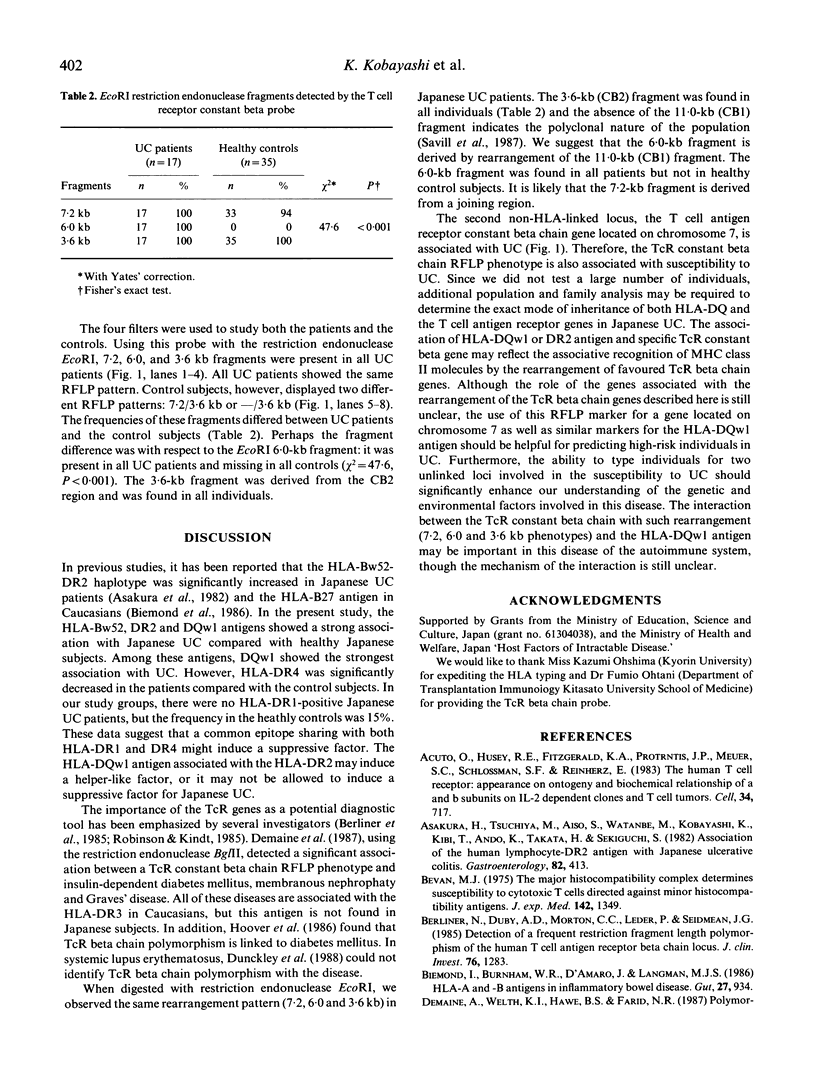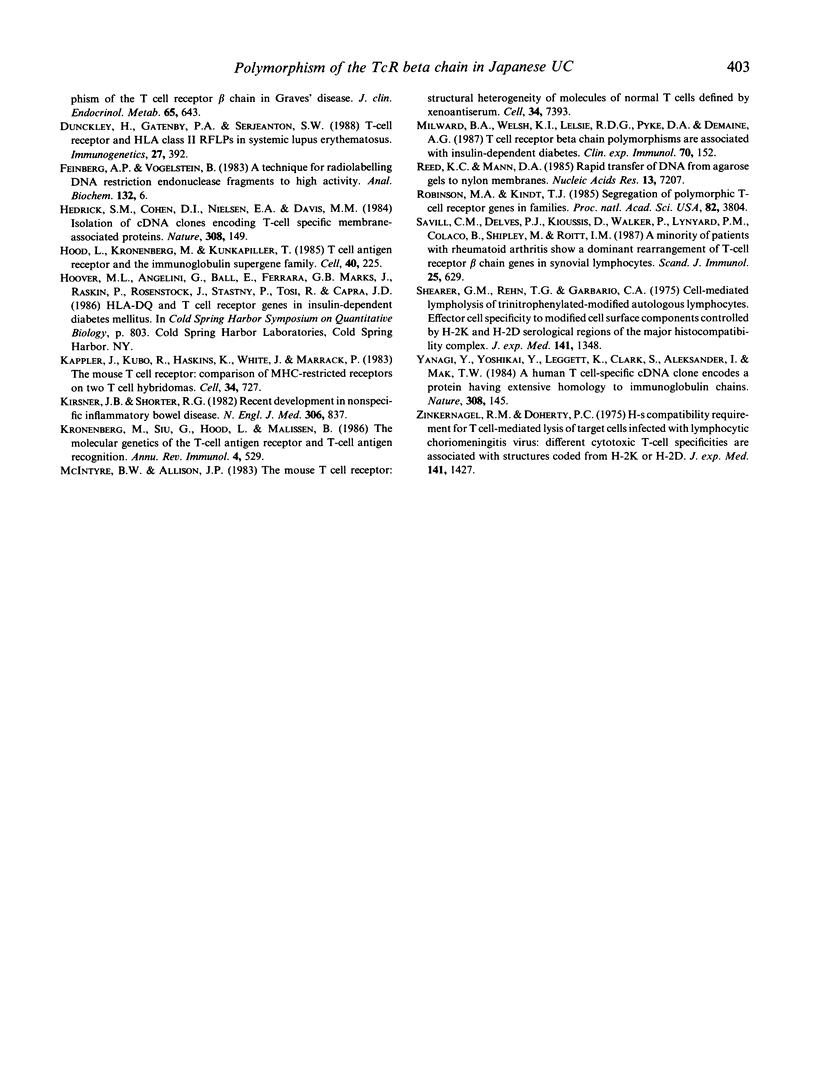Abstract
We studied the T cell antigen receptor (TcR) constant beta chain genes on HLA typed Japanese patients with ulcerative colitis (UC). A TcR constant beta EcoRI 6.0-kb fragment was present in all Japanese UC patients (n = 17) but completely absent in the controls (n = 35) (chi2 = 47.6, P less than 0.001). The frequency of HLA-DR2 antigen was significantly higher in UC patients (85% versus 28% in controls, P less than 0.001). Furthermore, HLA-DQw1 antigen was also increased in UC patients (96% versus 60% in controls, P less than 0.001). However, HLA-DR4 antigen was significantly decreased in UC patients (12% versus 37%, P = 0.02). HLA-DR1 antigen was not found in UC patients and was present in only 15% of the controls. These results suggest that TcR beta chain and HLA-DQw1 antigen may be important in the pathogenesis of Japanese UC.
Full text
PDF



Images in this article
Selected References
These references are in PubMed. This may not be the complete list of references from this article.
- Acuto O., Hussey R. E., Fitzgerald K. A., Protentis J. P., Meuer S. C., Schlossman S. F., Reinherz E. L. The human T cell receptor: appearance in ontogeny and biochemical relationship of alpha and beta subunits on IL-2 dependent clones and T cell tumors. Cell. 1983 Oct;34(3):717–726. doi: 10.1016/0092-8674(83)90528-7. [DOI] [PubMed] [Google Scholar]
- Asakura H., Tsuchiya M., Aiso S., Watanabe M., Kobayashi K., Hibi T., Ando K., Takata H., Sekiguchi S. Association of the human lymphocyte-DR2 antigen with Japanese ulcerative colitis. Gastroenterology. 1982 Mar;82(3):413–418. [PubMed] [Google Scholar]
- Berliner N., Duby A. D., Morton C. C., Leder P., Seidman J. G. Detection of a frequent restriction fragment length polymorphism in the human T cell antigen receptor beta chain locus. A potential diagnostic tool. J Clin Invest. 1985 Sep;76(3):1283–1285. doi: 10.1172/JCI112086. [DOI] [PMC free article] [PubMed] [Google Scholar]
- Bevan M. J. The major histocompatibility complex determines susceptibility to cytotoxic T cells directed against minor histocompatibility antigens. J Exp Med. 1975 Dec 1;142(6):1349–1364. doi: 10.1084/jem.142.6.1349. [DOI] [PMC free article] [PubMed] [Google Scholar]
- Biemond I., Burnham W. R., D'Amaro J., Langman M. J. HLA-A and -B antigens in inflammatory bowel disease. Gut. 1986 Aug;27(8):934–941. doi: 10.1136/gut.27.8.934. [DOI] [PMC free article] [PubMed] [Google Scholar]
- Demaine A., Welsh K. I., Hawe B. S., Farid N. R. Polymorphism of the T cell receptor beta-chain in Graves' disease. J Clin Endocrinol Metab. 1987 Oct;65(4):643–646. doi: 10.1210/jcem-65-4-643. [DOI] [PubMed] [Google Scholar]
- Feinberg A. P., Vogelstein B. A technique for radiolabeling DNA restriction endonuclease fragments to high specific activity. Anal Biochem. 1983 Jul 1;132(1):6–13. doi: 10.1016/0003-2697(83)90418-9. [DOI] [PubMed] [Google Scholar]
- Hedrick S. M., Cohen D. I., Nielsen E. A., Davis M. M. Isolation of cDNA clones encoding T cell-specific membrane-associated proteins. Nature. 1984 Mar 8;308(5955):149–153. doi: 10.1038/308149a0. [DOI] [PubMed] [Google Scholar]
- Hood L., Kronenberg M., Hunkapiller T. T cell antigen receptors and the immunoglobulin supergene family. Cell. 1985 Feb;40(2):225–229. doi: 10.1016/0092-8674(85)90133-3. [DOI] [PubMed] [Google Scholar]
- Hoover M. L., Angelini G., Ball E., Stastny P., Marks J., Rosenstock J., Raskin P., Ferrara G. B., Tosi R., Capra J. D. HLA-DQ and T-cell receptor genes in insulin-dependent diabetes mellitus. Cold Spring Harb Symp Quant Biol. 1986;51(Pt 2):803–809. doi: 10.1101/sqb.1986.051.01.093. [DOI] [PubMed] [Google Scholar]
- Kappler J., Kubo R., Haskins K., White J., Marrack P. The mouse T cell receptor: comparison of MHC-restricted receptors on two T cell hybridomas. Cell. 1983 Oct;34(3):727–737. doi: 10.1016/0092-8674(83)90529-9. [DOI] [PubMed] [Google Scholar]
- Kirsner J. B., Shorter R. G. Recent developments in nonspecific inflammatory bowel disease (second of two parts). N Engl J Med. 1982 Apr 8;306(14):837–848. doi: 10.1056/NEJM198204083061404. [DOI] [PubMed] [Google Scholar]
- Kronenberg M., Siu G., Hood L. E., Shastri N. The molecular genetics of the T-cell antigen receptor and T-cell antigen recognition. Annu Rev Immunol. 1986;4:529–591. doi: 10.1146/annurev.iy.04.040186.002525. [DOI] [PubMed] [Google Scholar]
- Millward B. A., Welsh K. I., Leslie R. D., Pyke D. A., Demaine A. G. T cell receptor beta chain polymorphisms are associated with insulin-dependent diabetes. Clin Exp Immunol. 1987 Oct;70(1):152–157. [PMC free article] [PubMed] [Google Scholar]
- Reed K. C., Mann D. A. Rapid transfer of DNA from agarose gels to nylon membranes. Nucleic Acids Res. 1985 Oct 25;13(20):7207–7221. doi: 10.1093/nar/13.20.7207. [DOI] [PMC free article] [PubMed] [Google Scholar]
- Robinson M. A., Kindt T. J. Segregation of polymorphic T-cell receptor genes in human families. Proc Natl Acad Sci U S A. 1985 Jun;82(11):3804–3808. doi: 10.1073/pnas.82.11.3804. [DOI] [PMC free article] [PubMed] [Google Scholar]
- Savill C. M., Delves P. J., Kioussis D., Walker P., Lydyard P. M., Colaco B., Shipley M., Roitt I. M. A minority of patients with rheumatoid arthritis show a dominant rearrangement of T-cell receptor beta chain genes in synovial lymphocytes. Scand J Immunol. 1987 Jun;25(6):629–635. doi: 10.1111/j.1365-3083.1987.tb01089.x. [DOI] [PubMed] [Google Scholar]
- Yanagi Y., Yoshikai Y., Leggett K., Clark S. P., Aleksander I., Mak T. W. A human T cell-specific cDNA clone encodes a protein having extensive homology to immunoglobulin chains. Nature. 1984 Mar 8;308(5955):145–149. doi: 10.1038/308145a0. [DOI] [PubMed] [Google Scholar]
- Zinkernagel R. M., Doherty P. C. H-2 compatability requirement for T-cell-mediated lysis of target cells infected with lymphocytic choriomeningitis virus. Different cytotoxic T-cell specificities are associated with structures coded for in H-2K or H-2D;. J Exp Med. 1975 Jun 1;141(6):1427–1436. doi: 10.1084/jem.141.6.1427. [DOI] [PMC free article] [PubMed] [Google Scholar]



